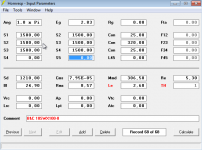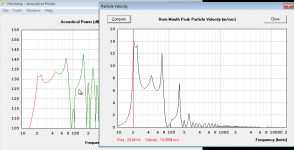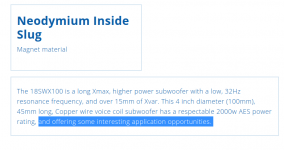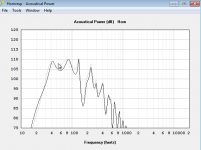Colleague of mime sent me a link for new model of B&C 18" subwoofer driver:
18SWX100 LF Drivers - B&C Speakers
Interesting animal with longer copper voice coil, more cone excursion capabilities and more power input.
The motor is not that efficient though. Dangit! Another miss after my prayers for 18DS152 or 21DS152 with longer coil.
The speaker likes larger box volumes.
Any thoughts on this one?
18SWX100 LF Drivers - B&C Speakers
Interesting animal with longer copper voice coil, more cone excursion capabilities and more power input.
The motor is not that efficient though. Dangit! Another miss after my prayers for 18DS152 or 21DS152 with longer coil.
The speaker likes larger box volumes.
Any thoughts on this one?
Doesn't seem as good as the BMS 18N862 as a high excursion reflex sub:
http://www.bmsspeakers.com/fileadmin/bms-data/product_data_2012/bms_18n862_t_data_2012-02.pdf
Probably cheaper though!
http://www.bmsspeakers.com/fileadmin/bms-data/product_data_2012/bms_18n862_t_data_2012-02.pdf
Probably cheaper though!
Looks partially similar, but B&C has nearly 2* stiffer suspension it seems. And very progressive. That does not look good in my eyes against BMS.
// In the simulation, it looks like BMS is two thirds of a dB more sensitive, and B&C will eat more power to compensate. But large signal behavior in real life might be very different. B&C might be stiff and burn some power on suspension, and BMS might not manage to hold center position as well as B&C.
I would like to hear some technical detail from mr. Prescott and other pros, what they have to say about such comparison.
// In the simulation, it looks like BMS is two thirds of a dB more sensitive, and B&C will eat more power to compensate. But large signal behavior in real life might be very different. B&C might be stiff and burn some power on suspension, and BMS might not manage to hold center position as well as B&C.
I would like to hear some technical detail from mr. Prescott and other pros, what they have to say about such comparison.
Last edited:
BMS motor force: 117
B&C motor force: 117
Same xmax, other parameters very similar. Shame no one is publishing full Kipple data we know they have.
B&C motor force: 117
Same xmax, other parameters very similar. Shame no one is publishing full Kipple data we know they have.
B&C and BMS produce their Xmax number very differently.
BMS produces "standard real" Xmax - (hvc-hag)/2 where B&C value would be 15.5mm and BMS is 19mm. But that is not the whole story. Simply put, it is not comparable really.
//I have already sent the request. Fingers crossed. They always provided this kind of data to me.
B&C has stiffer suspension and heavier cone assy.
It is very hard to predict how they behave in large signal.
My wild guess is that B&C compensates with more power input and modern design, while BMS pretty much at least holds its own against B&C with longer coil and more compliant suspension.
I believe that if you ask, the B&C support will give you the Klippel data. I might try as well.
BMS produces "standard real" Xmax - (hvc-hag)/2 where B&C value would be 15.5mm and BMS is 19mm. But that is not the whole story. Simply put, it is not comparable really.
//I have already sent the request. Fingers crossed. They always provided this kind of data to me.
B&C has stiffer suspension and heavier cone assy.
It is very hard to predict how they behave in large signal.
My wild guess is that B&C compensates with more power input and modern design, while BMS pretty much at least holds its own against B&C with longer coil and more compliant suspension.
I believe that if you ask, the B&C support will give you the Klippel data. I might try as well.
Last edited:
Qts of 0.46 isn't great. It'll want a big ported box tuned low, meaning it'll likely reach mechanical limits well before thermal. Could be fun in the right application, though.
Chris
Chris
Indeed, if you push it too low, about any 18“ will end up being excursion limited. In optimized application, these limits will be very close though. My 21DS115 was mostly power limited. I could smell it.
You got to reach one limit or the other, so excursion limitation isn't really a shame or big issue. If large excursion 18“ isn't enough in your application, then you possibly are not in the market anyways. I would be, if I could slam it into very compact bin. That is not possible with this one though, (un) fortunately.
You got to reach one limit or the other, so excursion limitation isn't really a shame or big issue. If large excursion 18“ isn't enough in your application, then you possibly are not in the market anyways. I would be, if I could slam it into very compact bin. That is not possible with this one though, (un) fortunately.



A great driver for a budget friendly home theater sub.
Plywood is cheaper then additional drivers and amps. For those having the space to spare but not the money for high end drivers and amps, it does circumvent a lot of problems. With a large enough cross section area - simple to build - tapped pipe design it will keep the mouth velocity low even at high power, long excursion low frequency content (HT bass) reproduction.
Out of quriosity, how would this driver sim in the ROAR18? It may not be the parameter balancing we normally go for but still.
The speaker disappeared from B&C and web. Wanted to see TS parameters again, and it´s gone. Hmmm...
Yes, it is not very strong driver, therfore I would not recommend it for advanced loading scenarios as ROAR bin.
Yes, it is not very strong driver, therfore I would not recommend it for advanced loading scenarios as ROAR bin.
It looks more like the KS28 driver (probably still somewhat different), and SB28 had the 18N850v2. KS28 is a very good improvement over the SB28 in my eyes, much cleaner, and should have 3dB extra output over the SB28.
Well, I would call it an important driver in their portfolion. But especially B&C spoiled us so much, that we want more. 🙂
The speaker disappeared from B&C and web. Wanted to see TS parameters again, and it´s gone. Hmmm...
Me too!
Does anyone have the pdf? I would like to see it too.
Since the DS drivers launched I've wanted to see them trade some motor force for excursion.
The real issue is that B&C simply refuse to invest in longer travel soft parts to make longer excursion drivers a reality. I think this goes back as far as the IPAL drivers, pretty sure they were suspension limited.
Since the DS drivers launched I've wanted to see them trade some motor force for excursion.
The real issue is that B&C simply refuse to invest in longer travel soft parts to make longer excursion drivers a reality. I think this goes back as far as the IPAL drivers, pretty sure they were suspension limited.
You COULD use the HR screen in post #8. Double click on the Sd number and see the T/S parameters. It's possible they let HR calculate all the other parameters.
Since the DS drivers launched I've wanted to see them trade some motor force for excursion.
Can you elaborate? I wonder what would it take if they just made the coil 6-8mm longer. It probably would not change the driver "that much" while maintaining nice motor force.
Regarding suspension, I have the same feeling in a way. Not 100% sure if it is decision for speaker reliability or cheaping out.
Mathematically to me it seems that stiffer suspension is a good thing. Stiffer suspension might also protect the coil and cone from rocking modes, therefore you can put the coil in narrower gap and get more Bl to offset the stiffness disadvantage partially. But softer suspension with longer throw would obviously be "of use/usable" for many, including me.
Shame. That is exactly the reason I'm also looking elsewhere.
Last edited:
The real issue is that B&C simply refuse to invest in longer travel soft parts to make longer excursion drivers a reality. I think this goes back as far as the IPAL drivers, pretty sure they were suspension limited.
There was some commentary in YouTube videos that they had tried very advanced suspensions that allowed longer excursions but they where too expensive. I wonder what they where? I have thought about things like piston rings that would be very expensive and impractical.
Now B&C own 18sound could they get something from them?
Eighteen Sound - Professional loudspeakers
In their target market of prosound though most of the time the compression in the low end is due to port/duct overload and not the driver excursion for practically realizable boxes. So perhaps this is not a priority?
Well, in a way, only what it would take is larger spiders. Those tiny ones on DS models have size as their limitation I would guess.
But they decided on this big time, and now for larger spiders, they would need to retool all basket gear.
To my knowledge, one port does not add much efficiency. I wonder if it wouldn't be better way and space saving, if speaker did more of the job, and port would do less job. I.E.: undertune even more, cut or EQ port down a bit, therefore reduce airflow, reduce port size, and let the speaker cone do the job. That is exactly why I put 21“ in small undertuned box. The port lightly reduces cone excursion needs compared to closed box, and large displacement driver takes care about the rest. 100% happy eith the solution.
But they decided on this big time, and now for larger spiders, they would need to retool all basket gear.
To my knowledge, one port does not add much efficiency. I wonder if it wouldn't be better way and space saving, if speaker did more of the job, and port would do less job. I.E.: undertune even more, cut or EQ port down a bit, therefore reduce airflow, reduce port size, and let the speaker cone do the job. That is exactly why I put 21“ in small undertuned box. The port lightly reduces cone excursion needs compared to closed box, and large displacement driver takes care about the rest. 100% happy eith the solution.
- Home
- Loudspeakers
- Subwoofers
- New B&C Speakers driver 18SWX100
